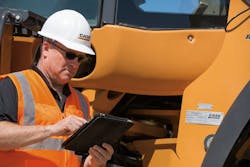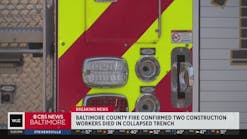Reprinted with the permission of Equipment Manager magazine, the magazine of AEMP.
The simple truth is: Construction machines are dangerous.
If not inspected regularly and maintained properly, components such as heavy buckets, quick couplers and hydraulic lines can malfunction, causing serious damage or worse to man and machine.
“Even a blown line can drop a boom and arm into a ditch with people in it,” says John Waldron, product manager for North America, at Volvo Construction Equipment. “For instance, one of the things many operators don’t understand is that machine hydraulics are running well over 4,000 psi. To put that into perspective, a power washer can cut a brick in half at 2,000 psi, so you can image what an equipment hydraulic line can do to human skin.”
Safety is the most important responsibility of all fleet and asset managers, dealers and equipment manufacturers, he says. “People’s lives are at stake, their well-being is at stake and the well-being of their families is at stake. The price of a machine is nothing compared with the value of a human life.”
Volvo takes safety seriously, Waldron says. The company tries to make every machine series it manufactures safer and more user-friendly. That includes technology and creature comforts for the operator. “If the operator is comfortable and the machine is reliable, at the end of the day operator fatigue is reduced,” he says.
In addition to the human benefits of safety, says Jason Ruggles, CEM and corporate shop manager for Traylor Bros., there are corporate benefits.
“Safety affects the bottom line, if you can get people to believe it,” he says. “That line item on the blue sheet—that piece of machinery—or that operator and the task they have to perform saves money. If any little piece of that equipment fails or if an operator slips, that costs money.”
By mitigating such incidents as much as possible, the one source that drives profits these days has been improved, he says. Insurance cost is another way safety can impact the business side of an organization. “It affects the work you can bid, your modifier that is used in the bidding process,” says Ruggles.
Brad Stemper, solutions marketing manager for Case Construction Equipment, says safety “ranks above all other key performance indicators. Employee health translates to the machines they operate and their surroundings.”
The responsibility of any asset manager, Stemper says, is to make sure everything possible is done to provide equipment operators with well-maintained machines suitable for work.
“In some cases, equipment failures can lead to injury as well as damages and liability to the site or nearby property,” Stemper says. “Safety should always be first priority. When machines are performing as they should, operators can concentrate on the task at hand and be more aware of their actions.”
Craig Denny, manager of product safety and technical engineering at John Deere Construction & Forestry, agrees.
“Nobody wants an operator, technician or bystander to get hurt by construction equipment,” Denny says. “But beyond that, there is a moral obligation to provide workers as safe a work environment as is feasible. All risk cannot be eliminated, but employers should strive to control what they reasonably can.”
John Brewington, CEM, is owner of the consulting firm Brewington & Co. and was chairman of AEMP’s CEM Commission in 2013. He says everything fleet managers do should be focused on safety—not only the safety of personnel, but also the safety of others who might be working on the job site and safety of the general public.
“At the end of the day,” he says, “the goal is that we have accomplished our work without anyone being harmed. That’s why machine safety is and should continue to be in the forefront.”
The emphasis on making the construction industry and its rolling stock safer goes back decades, but of all the equipment changes that have come about as a result, seatbelts and roll-over protection structures are two of the most crucial safety features on machines today, says Denny.
A number of other significant improvements have been made in construction equipment during the past five years, Stemper says. Some of the changes came about by government mandate, such as the technology to meet emissions regulations. Those mandates, he says, spurred Case and other manufacturers “to take a closer look at how we build machines and how engine performance relates to the application and use of a machine.
“But we want to go beyond that,” he says. “We want to build machines that do more than just meet the mandates. From our perspective, Tier 4 mandates simply provide another opportunity for us to improve our product.”
Telematics is another significant advance that can improve safety, says Stemper. It is a technology “that has the ability to completely change the way we perform equipment service, whether you have a fleet of five or 50.”
From the end user point of view, Ruggles identified the most significant change in the past five years as “the push from the end user to the OEM. At Traylor, for instance, if we see something we want on a new piece of equipment we intend to buy, we go directly to the manufacturer. For example, we want hand rails that go up further or we want a little wider platform for technicians. If it were up to me, I’d like to see all walkways, catwalks and steps bigger. Who wants to back out of a cab and close the door behind them?”
Traylor works with the manufacturer to make equipment changes at the manufacturing level before the machine is delivered. “We’ve done that a number of times in the past with good results,” Ruggles says.
One of the most simple—and effective—ways a company can instill the habit of equipment safety is the traditional walk-around inspection.
“Without observing the condition, position and all the surroundings of a piece of equipment you intend to move, you basically are saying safety isn’t important,” says Brewington. “That’s true of a truck, a crane or any other machine. But the fact is, walk-arounds are the best opportunity you have to determine if a potential defect is going to cause you issues later in the day. And, frankly, it is a requirement under certain circumstances.”
All machines have similarities for a walk-around inspection, according to Waldron. They all have cabs, engines, working hydraulics, parts that need to be lubricated and oils that need to be checked, “but each machine is different in its own way. You don’t have an articulation joint on most excavators, but you do on a loader and an articulated haul truck.” A crane inspection would include cables used for lifting and hook blocking.
Each type of equipment differs in what needs to be inspected, he says. For excavators, daily maintenance checks include oil, fluids, lubes, filters and checking for loose parts and inspecting any functional parts, such as wipers, lights and mirrors. The inspection makes sure everything is in place. Even windows should be checked for damage or dirt, he says. “Visibility allows you to operate in a safe and productive manner.”
Naturally, all areas of the machine are important, he says. Digging equipment and the cab are areas of focus. With engine and hydraulics, it is important to make sure there are no leaks or cracked hoses.
Denny agrees. “Pre-operation inspections are one of the most basic yet important things an operator can do prior to starting the work day,” he says. “In addition to completing daily maintenance items to help keep the machine running at peak efficiency—which improves safety—it also provides the opportunity to inspect things such as hoses and fittings, electrical wiring, guards and shields and warning decals and devices.”
Daily equipment walk-around inspections, both before and after operation, are an essential part of the day, says Stemper. “These walk-arounds provide the best opportunity to identify and correct possible issues before they become bigger problems,” he says.
Walk-around inspections are so important, they should be done at the beginning of every shift, not just once a day, according to Ruggles.
“One, it is a quick inspection of equipment condition,” he says. “If you have a low tire on a loader and you’re getting ready to load trucks, you could tip it over and do damage. It’s easier to report that to a mechanic than to call and ask him to bring a $50,000 tire.”
Two, says Ruggles, walk-around inspections “align your head with the machine. It’s 7:00, you get out of a meeting, you walk to the machine, take five minutes to walk around it, kick the tires and look at the bucket. Your head gets into the game right away. “
Walk-arounds should be done with a simple check sheet, he says. “Check sheets help you remember what to look for. They take what is in your memory and put it on paper so you can see what you remember. For instance, you might know you have to take a bolt out, but not realize you haven’t put a jack under there.”
Although walk-around inspection check lists suggested by OEMs many times make up the basis for a company’s check sheet, more likely than not individual companies come up with their own tailor-made version.
“At Traylor, we call activity hazard analysis (AHA) ‘ah-ha’ sheets,” says Ruggles. “In my opinion, AHA sheets are the same as job site hazard analysis (JHA) sheets. We use them for any activity that is out of the norm that really should be done, anything except for routine items.”
Any kind of form or sheet can be used, he says. What you’re trying to do is write down the steps of a particular activity and call out the hazards associated with that particular activity.
Another important part of equipment safety is how operators and technicians climb on and off the machine. Ruggles says access and egress should be the same, but in reality, “I don’t know that they actually are. Operator catwalks and hand-hold stairs tend to be a little smaller to allow the operator into the cab. For technicians, by comparison, walkways and catwalks need to be wide enough to allow them to kneel and have someplace to put their tool bag or even to pull out a seat to work on something,” he says.
Many equipment surfaces have rigid grating or other slip-proof designs to ensure stability. Manufacturers have often been able to move service points to a more accessible level. If technicians have to climb on the machine, Case recommends they place their tools on the equipment from the ground or have someone else on-site to hand the tools to the technician.
“The safe way to get on and off a piece of equipment is the same for operators and technicians,” Denny says. “Maintain three points of contact; keep boots, steps and platforms clean and never jump off a machine. Follow the instructions outlined in the operator’s manual.”
“We’re always going to have improved ergonomics, handholds and surfaces as equipment gets smaller and better,” Ruggles says. “Whatever changes lie ahead, safety will always be on the front line.”





